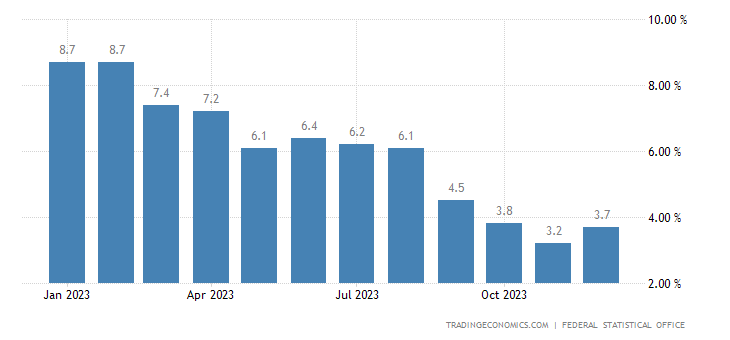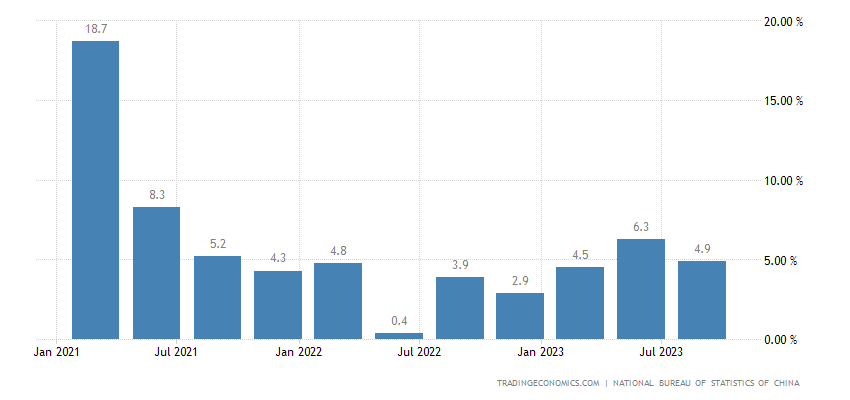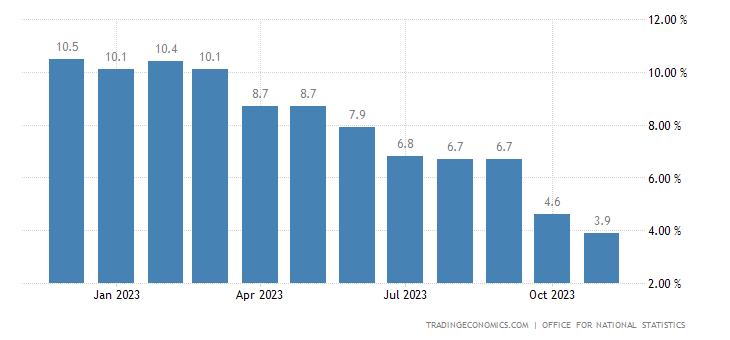We have started a new quarter, which means the inauguration of the corporate earnings season. To start with, banks will present data. In addition, in the coming week we can expect the publication of a number of inflation data from Germany, the UK and the euro area. We will also find out whether China's economy will emerge from a period of slowdown.
Table of contents:
- German consumer price index (CPI) on a monthly basis (December)
- China's gross domestic product (GDP) annualised (Q4)
- UK consumer price index (CPI) annualised (December)
- Eurozone consumer price index (CPI) annualised (December)
- Stocks to watch
Tuesday, 16.01, 7:00 GMT, German consumer price index (CPI) on a monthly basis (December)
The CPI monitors changes in the prices of consumer goods and services. The CPI is an important indicator because it helps us to understand trends in consumers' purchases and the impact of inflation on their purchasing power. It is calculated on the basis of a basket representing typical consumer spending, covering various categories such as food, housing, transport, etc. Regular measurements of the CPI allow us to track how the prices of these products and services change over time. A positive CPI indicates an overall increase in the prices of goods and services.
On the other hand, a negative CPI means that prices are lower than the year before. It is an important tool for economists and policymakers to help them understand the impact of inflation on the economy and take appropriate action. For consumers, it is information about how their money is losing value in the context of rising or falling prices, allowing them to adjust spending, plan savings and make financial decisions.
Preliminary data on consumer price inflation (CPI) in Germany show that it rose to 3.7% year-on-year, up from last month's low of 3.2%. This increase was mainly due to a 4.1% jump in energy prices (compared to 4.5% y-o-y in November). This was the aftermath of base effects related to the so-called December Emergency Assistance programme. Under this programme, the federal government covered the cost of monthly gas and heating allowances for households once in December 2022. At the same time, the rate of growth in food prices eased to 4.5 per cent (compared to 5.5 per cent in November) and service price growth cooled to 3.2 per cent (compared to 3.4 per cent in November). Core inflation, excluding volatile components such as food and energy, fell to 3.5%, reaching its lowest level since July 2022.
The current analyst consensus is for the preliminary annual reading to remain at 3.7% and the month-on-month reading to remain at 0.1%.

Source: Tradingeconomics.com
A higher-than-expected reading could have a bullish impact on the EUR, while a lower-than-expected reading could be bearish for the EUR.
Impact: EUR
Wednesday, 17.01, 2:00 GMT, China's gross domestic product (GDP) annualised (Q4)
Gross domestic product (GDP) indicates the total value of goods and services produced in a country for a certain period. GDP is an important indicator of the health of an economy because it gives an overall picture of how well or poorly it is doing. If the GDP growth is higher than expected, the economy is in good shape and growing faster than expected. On the other hand, if the GDP growth is lower than expected, the economy performs weaker than anticipated. Furthermore, if the GDP growth is negative for two consecutive quarters, it may be considered a technical recession due to contracting economic output.
China's economy grew at a year-on-year rate of 4.9% in Q3 2023, beating market forecasts of 4.4% and raising hopes of reaching the official annual target of around 5% this year. This was the result of continued stimulus from Beijing, which offset the impact of a protracted property crisis and weakened foreign trade. Nonetheless, retail sales expanded in September by the strongest margin in four months, rising for the ninth consecutive month, and industrial production growth remained at its highest level since April 2023. At the same time, the unemployment rate fell to a 22-month low of 5%, while fixed investment continued to grow for nine consecutive months in 2023. Earlier data showed that exports fell at a slower pace, partly due to the peak shipping season for Christmas products. Looking at the three quarters of last year, the economy grew by 5.2%. Last year, China's GDP grew by 3%, missing the official target of around 5.5%.
However, current analyst forecasts suggest that the annual target of 5.2% will be met. This would mean an end to the economic slowdown that has affected China due to pandemic restrictions.

Source: Tradingeconomics.com
A higher-than-expected reading could have a bullish impact on the CNY, while a lower-than-expected reading could be bearish for the CNY.
Impact: CNY
Wednesday, 17.01, 7:00 GMT, UK consumer price index (CPI) annualised (December)
The UK's annual inflation rate fell to 3.9% in November 2023, reaching its lowest level in two years, well short of forecasts of 4.4%. The biggest contributor to this fall was prices in the transport sector ( down 1.5% y-o-y compared to a 0.5% y-o-y increase), mainly due to reductions in car fuel prices and, to a lesser extent, used car prices, as well as maintenance, repairs and airfares. A second key factor appears to be the reduction in economic activity, reflected in stagnant GDP figures. Annual core inflation, which excludes food and energy prices, also fell to 5.1%, reaching its lowest level since January 2022.
The current analyst consensus points to a further decline in inflation to 3.8%. It seems that a deepening of economic weakness could even lead to deflation, as has happened in China, for example.

Source: Tradingeconomics.com
A higher-than-expected reading could have a bullish impact on the GBP, while a lower-than-expected reading could be bearish for the GBP.
Impact: GBP
Wednesday, 17.01, 10:00 GMT, Eurozone consumer price index (CPI) annualised (December)
After the official inflation data in Germany, we will receive the final reading of the inflation rate in the euro area. According to preliminary data, price dynamics rose to 2.9% year-on-year in December, slightly below the market consensus of 3%. This was the first increase in inflation since April. It was mainly driven by base effects related to energy prices. These recorded a fall of 6.7% year-on-year (compared with a fall of 11.5% in November). Inflation in the services sector remained at 4.0%. The annual core rate, which excludes volatile food and energy prices, also fell to 3.4%, in line with expectations and reaching its lowest level since March 2022.
Analysts' expectations suggest inflation forecasts will remain at 2.9% in the official reading. Inflationary concerns seem to have gone away for most economies in the euro area, struggling with the economic slowdown and the threat of recession.
euro_15.01.png)
Source: Tradingeconomics.com
A higher-than-expected reading could have a bullish impact on the EUR, while a lower-than-expected reading could be bearish for the EUR.
Impact: EUR
Stocks to watch
Morgan Stanley (MS) announces financial results for the quarter ending December 2023. Forecast EPS: 1.08. Positive earnings surprise in 8 of last 10 reports. Deadline: Tuesday, 16 January.
Goldman Sachs (GS) announces financial results for the quarter ending December 2023. Forecast EPS: 3.8. Positive earnings surprise in 7 of last 10 reports. Deadline: Tuesday, 16 January.
Charles Schwab (SCHW) announces financial results for the quarter ending December 2023. Forecast EPS: 0.6428 Positive earnings surprise in 8 of last 10 reports. Deadline: Wednesday, 17 January.
Grzegorz Dróżdż, CAI MPW, Market Analyst of Conotoxia Ltd. (Conotoxia investment service)
Materials, analysis and opinions contained, referenced or provided herein are intended solely for informational and educational purposes. Personal opinion of the author does not represent and should not be constructed as a statement or an investment advice made by Conotoxia Ltd. All indiscriminate reliance on illustrative or informational materials may lead to losses. Past performance is not a reliable indicator of future results.
CFDs are complex instruments and come with a high risk of losing money rapidly due to leverage. 71.98% of retail investor accounts lose money when trading CFDs with this provider. You should consider whether you understand how CFDs work and whether you can afford to take the high risk of losing your money.

